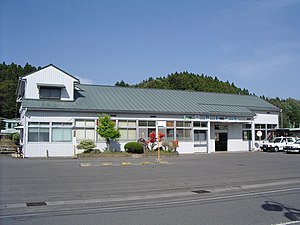Ononiimachi Station
This article needs additional citations for verification. (April 2020) |
Ononiimachi Station 小野新町駅 | |||||||||||||||
|---|---|---|---|---|---|---|---|---|---|---|---|---|---|---|---|
 Ononiimachi Station in August 2005 | |||||||||||||||
| General information | |||||||||||||||
| Location | Hiratate Yatsuzaku 10, Ono-machi, Tamura-gun, Fukushima-ken 963-3402 Japan | ||||||||||||||
| Coordinates | 37°16′33″N 140°38′12″E / 37.2759°N 140.6367°E | ||||||||||||||
| Operated by | |||||||||||||||
| Line(s) | ■ Ban'etsu East Line | ||||||||||||||
| Distance | 40.1 km from Iwaki | ||||||||||||||
| Platforms | 1 island platform | ||||||||||||||
| Other information | |||||||||||||||
| Status | Staffed (Midori no Madoguchi) | ||||||||||||||
| Website | Official website | ||||||||||||||
| History | |||||||||||||||
| Opened | March 21, 1915 | ||||||||||||||
| Passengers | |||||||||||||||
| FY 2018 | 390 daily | ||||||||||||||
| Services | |||||||||||||||
| |||||||||||||||
| |||||||||||||||
Ononiimachi Station (小野新町駅, Ononiimachi-eki) is a railway station in the town of Ono, Tamura District, Fukushima Prefecture, Japan operated by East Japan Railway Company (JR East).
Lines[edit]
Ononiimachi Station is served by the Ban'etsu East Line, and is located 40.1 rail kilometers from the official starting point of the line at Iwaki Station.
Station layout[edit]
The station has a single island platform connected to the station building by an underground passage. The station has a Midori no Madoguchi staffed ticket office.
Platforms[edit]
| 1 | ■ Ban'etsu East Line | for Miharu and Kōriyama |
| 2 | ■ Ban'etsu East Line | for Iwaki |
History[edit]
Ononiimachi Station opened on March 21, 1915. The station was absorbed into the JR East network upon the privatization of the Japanese National Railways (JNR) on April 1, 1987.
Passenger statistics[edit]
In fiscal 2018, the station was used by an average of 390 passengers daily (boarding passengers only).[1]
Surrounding area[edit]
 National Route 349
National Route 349- Ono Town Hall
- Ono Niimachi Post Office
See also[edit]
References[edit]
- ^ 各駅の乗車人員 (2018年度) [Station passenger figures (Fiscal 2018)] (in Japanese). Japan: East Japan Railway Company. 2019. Retrieved 11 April 2020.
External links[edit]
- JR East Station information (in Japanese)


